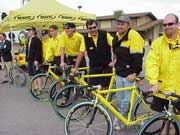Setting Up Neutral Tech Support Bicycles
 One of the subjects that tech support mechanics will have to face is how to set up spare bicycles. Spare bikes may be loaners, personal bikes or team spares but then the object is the same – to provide a race-quality machine, in a variety of sizes and fit, for any racer whose bike has a “terminal” or time consuming mechanical problems.
One of the subjects that tech support mechanics will have to face is how to set up spare bicycles. Spare bikes may be loaners, personal bikes or team spares but then the object is the same – to provide a race-quality machine, in a variety of sizes and fit, for any racer whose bike has a “terminal” or time consuming mechanical problems.
Frame size is the first consideration. Obviously, a 56 or 57 cm is the mid size pick if you only have one bike, but for truly adequate coverage, a program needs at least four bikes. My recommendation is as follows: a 50cm, a 54cm, a 57cm and a 60cm. This should give a pit or a follow vehicle enough choice to avoid any unridable match-ups between riders and spare bikes.
Second consideration is how to equip your bikes. Again, it is an obvious choice to put 44cm handlebars and the 175mm cranks on the largest frame and so on. Remember, your goal is an “average” bike set-up for that frame size. It’s better to maximize your available spare 9sp wheels, so setting up your tech bikes with 8-speed is an acceptable way to use those older rear wheels.
In order to maximize frame fit, I equip all my spare bikes with 330mm or taller seat posts. Avoid aero seat post designs – they can’t be lowered or raised enough to be of much help. Also, a quick release seat binder bolt is essential for rapid seat height adjustments.
Wheel choices should fall toward the heavy-duty range with 32 or 36 spokes. Clinchers are a lower maintenance, lower cost alternative to sew-ups, but remember all equipment needs to be 100% serviceable and top quality. Don’t give out a bike or a wheel you wouldn’t be willing to race yourself. And watch your gearing: What good is a wheel change if the spare has a 21 and the racer really needs a 23 to get around the course?
Pedal systems have become the #1 tech support problem. You’ve just got to aim for the “most typical” set up and deal with the odd-ball pedal/cleat/shoe combinations by doing a quick pedal swap from the broken bike to your spare. This doesn’t help if it’s a broken pedal, so you’ve got to build a stock of spare pedal systems to have in the pit of the follow vehicle for a quick change. A good all-around set up includes toe clip and strap bikes. Most cyclists can jam their feet into the clips for a short time allowing enough time to make repairs or change pedals. Since almost 60% of all pedal systems are Look style, followed by SPD and Speedplay, your bikes should reflect that fact.
A great set-up would be with Look and SPD pedals with toe clip adapters that snap in, such as those produced by Winwood. You could quickly remove the adapters if your rider’s shoes and spare bike’s pedals match, otherwise you’ve still got toe clips and straps.
So to recap – choose a variety of frame sizes, equipped with “average” size equipment with extra long posts and QR binders. As for pedals, stick with the most common types and toe clip/strap with a few extra odd-ball pedals to pull a fast switch. Keep the bikes in mid cog gear in the rear and on the large chainwheel or as the course dictates. Good Luck!
Karl Jackson – Toe Clips Summer `94 modified to match current components
